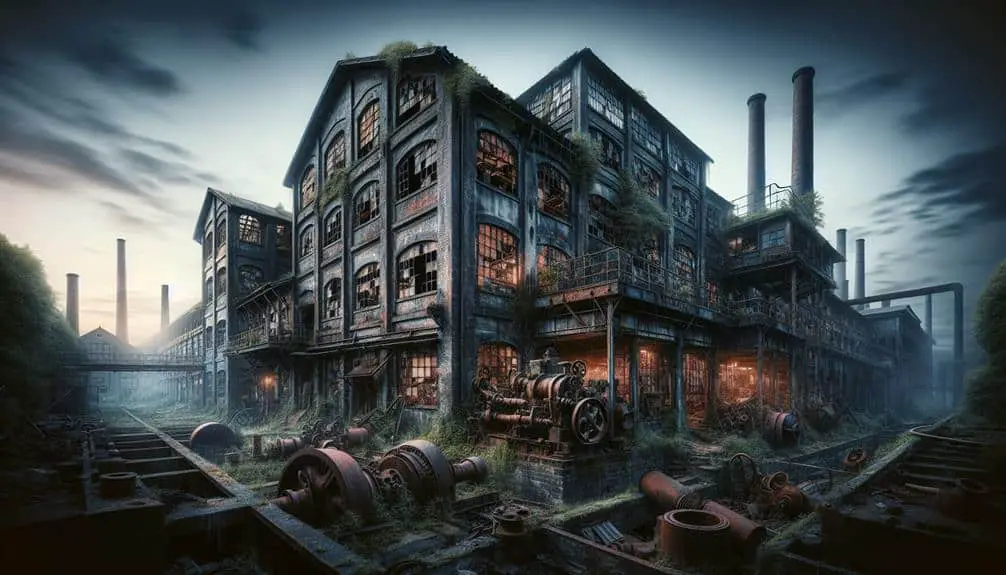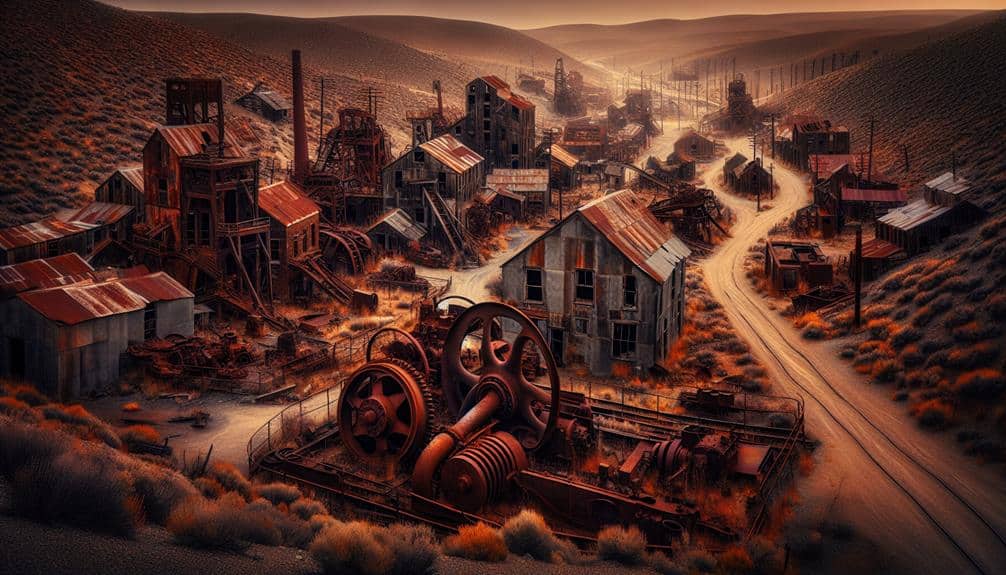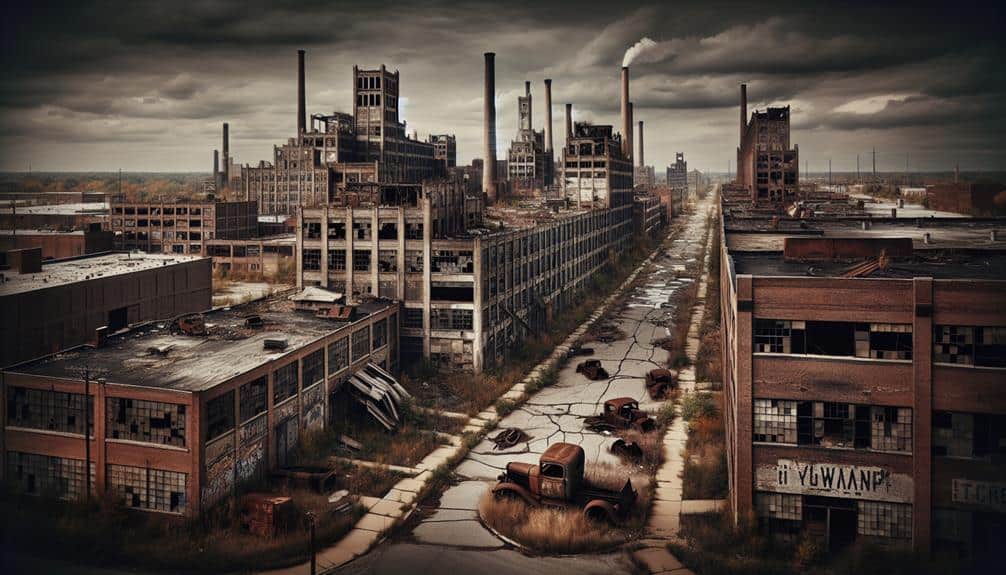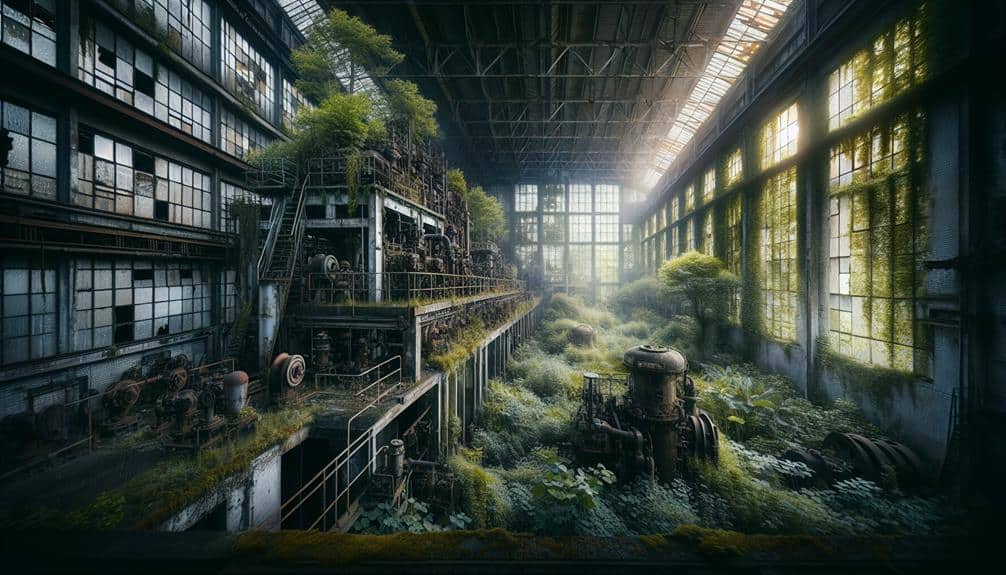Step into the forgotten echoes of vanished manufacturing communities where resilience and hope linger amidst ruins once teeming with life. Explore the industrial heritage sites that stand as poignant reminders of a bygone era. Discover how community resilience and grassroots initiatives breathe new life into abandoned factories, transforming them into vibrant hubs. Witness the beauty in decay as you reflect on the shifting industrial landscape. Uncover the lessons these vanished communities teach us about historical preservation and the importance of preserving our industrial heritage for future generations. The stories of these communities hold valuable insights waiting to be discovered.
Key Points
- Preserve historical buildings, artifacts, and machinery for storytelling.
- Transform abandoned factories into vibrant community hubs.
- Create living museums to narrate industrial stories.
- Foster pride and belonging through community revitalization efforts.
- Highlight resilience as a beacon for rebuilding and creating a new future.
Rise of Industrial Boomtowns
During the late 19th century, a wave of industrial boomtowns emerged across the country, reshaping the economic landscape and defining a new era of manufacturing prosperity. These towns were the heartbeat of innovation and progress, bustling with activity and promise. Urban renewal projects revitalized these areas, preserving the unique heritage of industrialization while creating new tourism opportunities for visitors seeking a glimpse into the past.
As industries flourished, communities flourished alongside them, creating a symbiotic relationship between progress and preservation. Industrial heritage sites now stand as monuments to the hard work and determination of those who built our nation. Through these sites, we can trace the footsteps of our ancestors and gain a deeper understanding of our industrial roots.
Impact of Economic Decline
As economic decline grips manufacturing communities, the once vibrant landscape now bears the scars of lost jobs and shuttered factories. The unemployment crisis has hit hard, leading to social disintegration and a sense of uncertainty. Families that once relied on stable manufacturing jobs are now facing poverty and financial hardship. The ripple effects are evident in the community, with businesses struggling as consumer spending decreases.
Amidst these challenges, there are glimmers of hope in the form of community resilience. People are coming together to support one another, finding innovative ways to create new economic opportunities. Grassroots initiatives and local organizations are working tirelessly to provide assistance to those in need and to revitalize the community spirit.
Despite the hardships caused by economic decline, there's a sense of determination in the air. The manufacturing communities may have been dealt a tough hand, but the people within them are refusing to give up. By standing strong together, they're paving the way for a brighter future.
Abandoned Factories and Infrastructure
Abandoned factories and crumbling infrastructure paint a stark picture of neglect and decay in once-thriving manufacturing communities. Urban exploration reveals the haunting beauty of industrial ruins, echoing the stories of the past while standing as monuments to history. As you navigate through these forgotten spaces, the peeling paint, rusty machinery, and shattered windows whisper tales of a bygone era. The decay in these abandoned factories serves as a reminder of the shifting industrial landscape and the communities left behind.
Exploring these industrial relics offers a glimpse into the past, showcasing the once-vibrant life that existed within these now desolate walls. Each broken brick and overgrown pathway narrates a story of resilience and downfall, shedding light on the challenges faced by these communities. While the decay may appear disheartening, it also presents an opportunity to reflect on the evolution of industry and the resilience of those affected by its decline. Through understanding the history embedded in these abandoned factories and infrastructure, we can honor the legacy of these manufacturing communities.
Resurrecting Forgotten Manufacturing Legacy
To revive the forgotten manufacturing legacy, communities must commence on a journey of restoration and reinvention, breathing new life into once-thriving industrial spaces. Heritage preservation plays an important role in maintaining the essence of these manufacturing communities, honoring the hard work and dedication of past generations. By preserving historical buildings, machinery, and artifacts, communities can create living museums that tell the stories of their industrial past.
Community revitalization is another key aspect of resurrecting the forgotten manufacturing legacy. It involves transforming abandoned factories and warehouses into vibrant hubs of activity, such as art studios, workshops, or community centers. This revitalization not only brings economic opportunities to the area but also fosters a sense of pride and belonging among residents. Through adaptive reuse and creative urban planning, communities can turn once-declining manufacturing neighborhoods into thriving cultural districts that celebrate their industrial heritage.
Lessons From Vanished Communities
Exploring the vanished communities offers valuable insights into the historical fabric of manufacturing legacies and the enduring impact of industrial decline on local societies. These communities teach us about the importance of community resilience in the face of economic challenges. By studying how these communities coped with the loss of their primary industries, we gain a deeper understanding of the human spirit's ability to adapt and persevere.
One significant lesson learned from vanished communities is the significance of historical preservation. Preserving the stories and memories of these communities allows us to honor their struggles and triumphs. It also serves as a reminder of the need to protect our industrial heritage for future generations.
The resilience shown by these communities serves as a beacon of hope, showing that even in the darkest times, people can come together to rebuild and create a new future. By learning from these vanished communities, we can appreciate the strength that lies within us all to overcome adversity and thrive once more.
Frequently Asked Questions
What Were the Primary Reasons for the Decline of Manufacturing Communities in the First Place?
You saw it happen – the economic shifts, the urban decay. Industries moved, jobs vanished. It was a cycle that left scars. Communities faded, dreams shattered. Understanding the reasons behind this decline is essential.
How Have the Environmental Impacts of Abandoned Factories and Infrastructure Been Addressed in These Communities?
To tackle environmental impacts, abandoned factories need remediation. Community engagement is key in this process. By working together, you can clean up contamination, restore nature, and make your surroundings healthier and more vibrant.
What Role Do Local Governments Play in the Revitalization Efforts of These Manufacturing Communities?
In the revitalization efforts of manufacturing communities, local governments play an essential role. They form local partnerships to drive economic development initiatives, creating opportunities for growth and renewal. Your involvement can shape the future of these communities.
Are There Any Unique Challenges Faced in Preserving the History and Heritage of These Vanished Manufacturing Communities?
When it comes to challenges in preserving the history and heritage of vanished manufacturing communities, you'll discover obstacles like limited resources, fading memories, and the struggle to maintain authenticity. Preservation techniques involve oral histories, archival research, and community engagement.
How Have the Skills and Knowledge of Past Generations in These Communities Been Preserved and Passed Down to Future Generations?
You think preserving traditions is a piece of cake, huh? Well, let's talk about passing down knowledge in manufacturing communities. Skills are like heirlooms – cherished, polished, and shared for generations to come.



